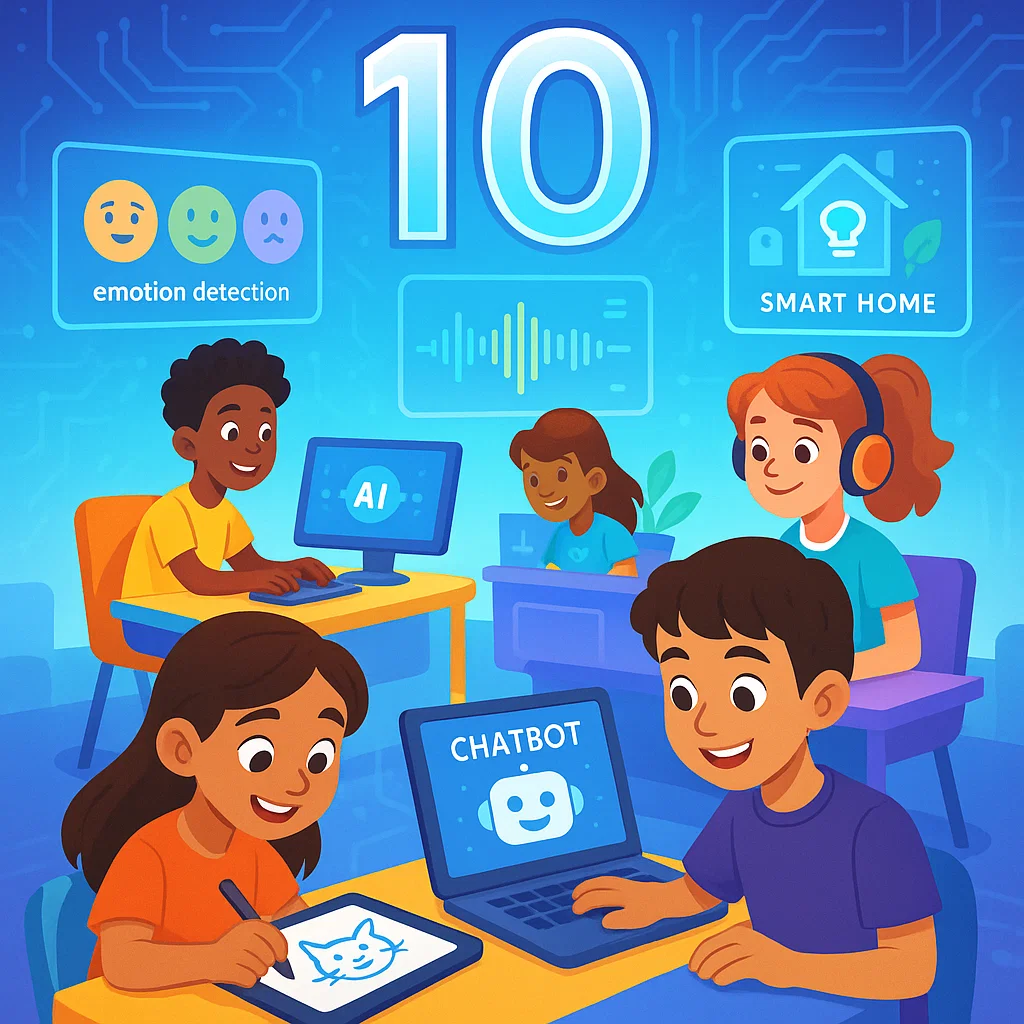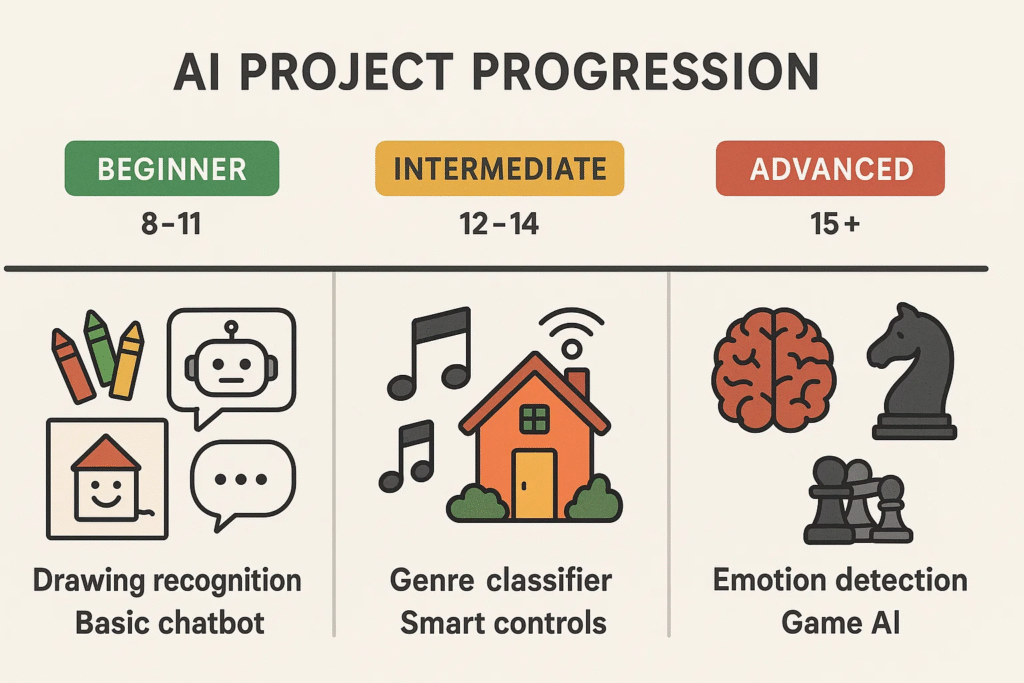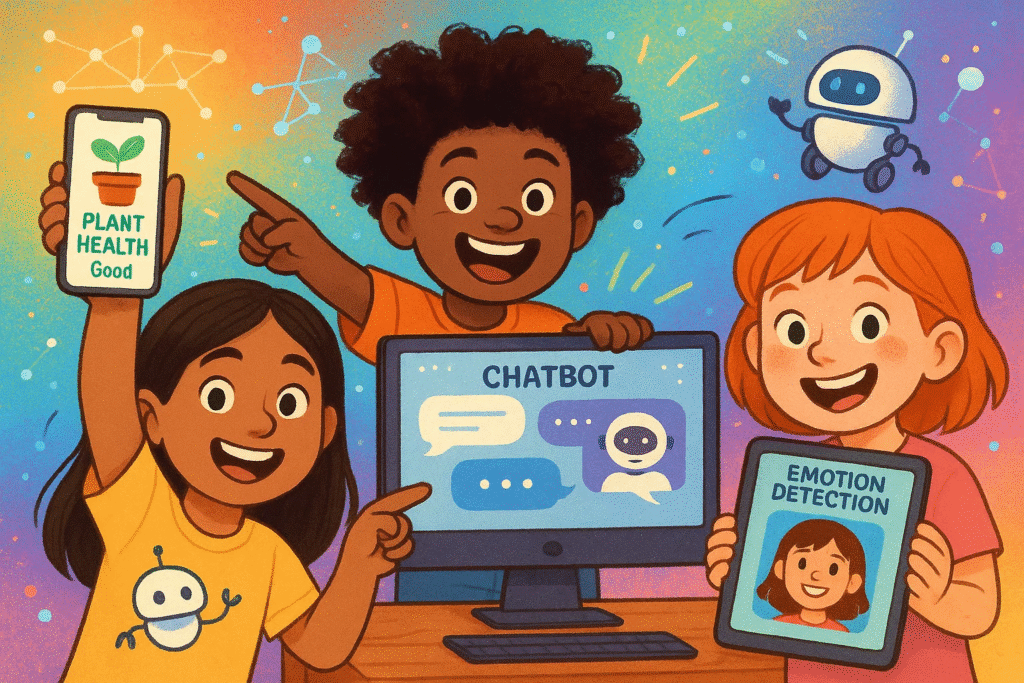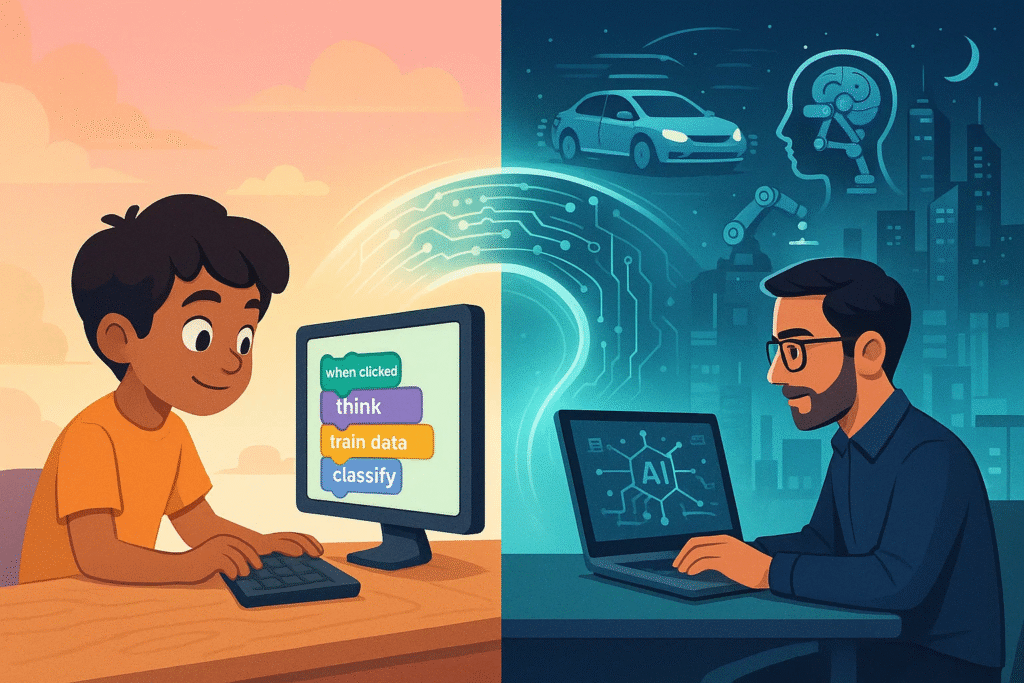
Reading Time: 8 mins

Imagine your child creating their own AI chatbot that can tell jokes, building a smart system that recognizes their drawings, or developing an AI that can predict the weather. These aren’t just dreams—they’re achievable AI projects that kids can actually build today!
As technology continues to reshape our world, artificial intelligence has become one of the most exciting and accessible fields for young learners. The best part? You don’t need a computer science degree to get started. With the right guidance and age-appropriate tools, kids as young as 8 can dive into the fascinating world of AI and machine learning.
In this comprehensive guide, we’ll explore 10 amazing AI projects that will spark your child’s curiosity, build their confidence, and give them hands-on experience with the technology that’s shaping our future.
Before we dive into the projects, let’s understand why AI education is so crucial for today’s young learners. According to recent studies, jobs requiring AI skills are expected to grow by 40% over the next decade. But beyond career preparation, AI projects offer incredible benefits:
Building Critical Thinking: AI projects teach kids to break down complex problems into manageable steps, fostering logical reasoning and analytical thinking.
Encouraging Creativity: From designing chatbot personalities to creating art with AI, these projects blend technology with imagination in ways that surprise even the most experienced educators.
Developing Problem-Solving Skills: Each AI project presents unique challenges that require creative solutions, building resilience and adaptability.
The beauty of modern AI education lies in its accessibility. Here’s what young innovators need to begin their AI journey:
Basic Computer Skills: Familiarity with using a computer, typing, and navigating simple interfaces Internet Access: For accessing online AI platforms and tools
Curiosity and Patience: The most important ingredients for any successful AI project
Adult Support: For guidance and encouragement throughout the learning process
Most AI projects for kids use visual programming languages like Scratch or user-friendly platforms that don’t require coding knowledge. This makes AI accessible to children who are just beginning their technology journey.

Age Range: 8-12 years
Difficulty: Beginner
Time Required: 2-3 hours
Platform: Google’s Teachable Machine
Kids love to draw, and this project combines their artistic passion with AI magic. Using Teachable Machine by Google, children can train an AI to recognize their drawings of different objects—cats, cars, flowers, or anything they can imagine.
What They’ll Learn: Pattern recognition, data collection, and how AI “sees” images
Real-World Application: This technology powers everything from photo organization apps to medical imaging systems.
Getting Started: Visit teachablemachine.withgoogle.com, choose “Image Project,” and start gathering examples of your drawings. The AI learns from your examples and can recognize similar images in real-time.
Age Range: 10-14 years
Difficulty: Beginner to Intermediate
Time Required: 3-4 hours
Platform: Machine Learning for Kids + Scratch
Every child dreams of having their own digital assistant. With this project, they can create a chatbot that knows their favorite jokes, helps with homework reminders, or even plays simple games.
What They’ll Learn: Natural language processing, conversation design, and user experience thinking
Fun Twist: Kids can give their chatbot unique personalities—maybe it’s a friendly robot from Mars or a wise owl that speaks in rhymes!
Getting Started: Create a text classification model at machinelearningforkids.co.uk, then import it into Scratch using their special extension blocks.
Age Range: 11-15 years
Difficulty: Intermediate
Time Required: 4-5 hours
Platform: Teachable Machine (Audio Project)
Music is universal, and this project lets kids explore how AI can understand and categorize different musical styles. They’ll train an AI to distinguish between pop, rock, classical, and other genres.
What They’ll Learn: Audio processing, feature extraction, and classification algorithms
Extension Ideas: Create playlists automatically or build a music recommendation system for friends and family.
Getting Started: Use Teachable Machine’s “Audio Project” feature to record short clips of different music genres and train your AI classifier.
Age Range: 12-16 years
Difficulty: Intermediate
Time Required: 5-6 hours
Platform: Scratch + Machine Learning for Kids
This project turns kids into meteorologists! Using historical weather data, they’ll build an AI that can predict tomorrow’s weather conditions.
What They’ll Learn: Data analysis, pattern recognition in time series, and the basics of prediction models
Real-World Connection: Professional weather forecasters use similar (though much more complex) AI systems to make their predictions.
Getting Started: Use Machine Learning for Kids to create a numbers classification model with weather data, then visualize predictions in Scratch.
Age Range: 10-14 years
Difficulty: Beginner to Intermediate
Time Required: 3-4 hours
Platform: Scratch with AI Extensions
Kids can design their dream smart home with this engaging project. They’ll create an AI system that can control lights, temperature, and security based on different scenarios.
What They’ll Learn: If-then logic, automation concepts, and user interface design
Family Fun: Parents can get involved by discussing real smart home applications and energy efficiency.
Getting Started: Use Scratch’s built-in sprites and variables to simulate home devices, adding AI decision-making through conditional blocks.
Age Range: 9-13 years
Difficulty: Beginner
Time Required: 2-3 hours
Platform: MIT App Inventor with DALL-E integration
Creativity meets technology in this exciting project where kids use AI to generate unique artwork based on their descriptions or style preferences.
What They’ll Learn: Creative AI applications, prompt engineering, and digital art concepts
Showcase Opportunity: Kids can create a digital gallery of their AI-generated art to share with friends and family.
Getting Started: Follow MIT App Inventor’s DALL-E tutorial to create your own generative art app.
Age Range: 11-15 years
Difficulty: Intermediate
Time Required: 4-5 hours
Platform: Machine Learning for Kids + Scratch
This fascinating project teaches kids to build an AI that can recognize facial expressions and determine emotions from photos or webcam feeds.
What They’ll Learn: Computer vision, facial recognition basics, and emotional intelligence in AI
Important Discussion: This project opens up great conversations about privacy, consent, and the ethical use of AI technology.
Getting Started: Create an image classification model for different facial expressions, then connect it to Scratch using the face detection extension.
Age Range: 12-16 years
Difficulty: Intermediate to Advanced
Time Required: 5-6 hours
Platform: Machine Learning for Kids + Scratch
Kids can build an AI that determines whether movie reviews, social media posts, or book reviews are positive, negative, or neutral.
What They’ll Learn: Text processing, sentiment analysis, and how AI understands human language
Practical Application: Understanding how companies use AI to monitor customer feedback and improve their products.
Getting Started: Create a text classification model with positive and negative examples, then build a Scratch interface for testing new text.
Age Range: 11-16 years
Difficulty: Intermediate to Advanced
Time Required: 6-8 hours
Platform: Scratch + PictoBlox (Enhanced Scratch with AI)
For kids who love gaming, this project lets them create an AI opponent for simple games like tic-tac-toe, connect four, or even a basic strategy game.
What They’ll Learn: Game theory, strategic thinking algorithms, and competitive AI concepts
Challenge Level: Start with simple games and gradually increase complexity as skills develop.
Getting Started: PictoBlox offers enhanced AI blocks that make creating game AI more accessible than traditional programming.
Age Range: 10-14 years
Difficulty: Intermediate
Time Required: 4-5 hours
Platform: Teachable Machine + MIT App Inventor
Combining AI with environmental science, kids can build a system that analyzes photos of plants to determine their health status and suggest care improvements.
What They’ll Learn: Image classification, environmental applications of AI, and interdisciplinary thinking
Green Connection: This project beautifully combines technology education with environmental awareness and responsibility.
Getting Started: Train an image classifier in Teachable Machine with photos of healthy and unhealthy plants, then create a mobile app interface using MIT App Inventor.

Start Small and Build Up: Begin with simpler projects and gradually tackle more complex challenges as confidence grows.
Embrace Mistakes: Every error is a learning opportunity. Encourage kids to experiment and iterate on their projects.
Document the Journey: Keep a project journal with screenshots, thoughts, and discoveries. This creates a wonderful record of learning progress.
Share and Celebrate: Let kids showcase their projects to family, friends, or online communities designed for young learners.
Connect to Real World: Help children understand how their projects relate to real-world applications and careers.

To get started with these amazing AI projects, here are the key platforms that make AI accessible to young learners:
Google’s Teachable Machine: A fast, easy way to create machine learning models for your sites, apps, and more – no expertise or coding required. Perfect for image, sound, and pose recognition projects.
Machine Learning for Kids: Provides hands-on experiences for training machine learning systems and building things with them in Scratch.
MIT App Inventor: MIT is building tools into App Inventor that will enable even beginning students to create original AI applications that would have been advanced research a decade ago.
Scratch: The visual programming language that makes coding accessible to kids, with AI extensions available.
PictoBlox: A programming software based on Scratch 3.0, hence basic functionality is similar. As additional features it has various extensions related to hardware, robotics, Artificial Intelligence and Machine learning.
Completing these projects is just the beginning of an exciting AI journey. Here’s how kids can continue building their skills:
Join Online Communities: Platforms like Code.org and Scratch have vibrant communities where young programmers share projects and learn from each other.
Participate in Competitions: Events like the AI4ALL competition provide opportunities to showcase skills and meet like-minded peers.
Explore Advanced Tools: As skills develop, kids can graduate to more sophisticated platforms like Python programming or specialized AI frameworks.
Consider Structured Learning: For comprehensive skill development, structured courses can provide systematic learning paths and expert guidance.

These 10 amazing AI projects represent more than just fun activities—they’re stepping stones toward understanding the technology that will define our future. Every project completed builds confidence, develops problem-solving skills, and opens doors to exciting possibilities.
The journey from curious beginner to confident AI creator doesn’t happen overnight, but with the right projects, guidance, and enthusiasm, any child can become part of the AI revolution. Whether your child dreams of creating the next breakthrough in healthcare AI, developing smarter video games, or solving environmental challenges with machine learning, these projects provide the foundation for those ambitions.
Ready to start your child’s AI adventure? The future belongs to those who understand and can work with artificial intelligence. By starting with these engaging, age-appropriate projects, you’re giving your child the tools to not just use AI, but to create with it, solve problems with it, and maybe even change the world with it.
The best time to start learning AI was yesterday. The second best time is right now. Let’s build the future together, one amazing AI project at a time!
Looking for expert guidance and structured AI learning for your child? Explore our comprehensive AI and Machine Learning classes for kids and teens where experienced instructors help young learners master these projects and much more through personalized, live online sessions.
